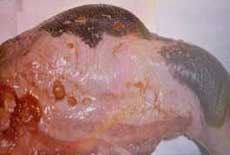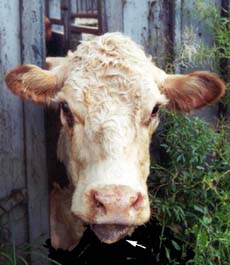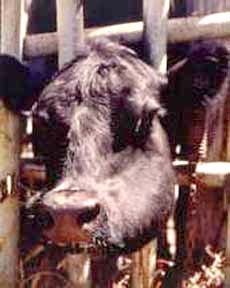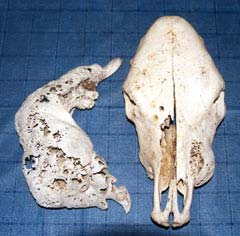What to Do for a Baby Calf With a Swollen Tongue
Introduction

Wooden tongue (actinobacillosis) and lumpy jaw (actinomycosis) occur throughout Commonwealth of australia, in cattle of all breeds, historic period and sex activity. Wooden natural language is more common than lumpy jaw. Normally only a pocket-size percent of animals are affected at any one time. The term 'actino' indicates that the inflammation acquired by these leaner results in the formation of pus containing sand-like granules. The granules are actually clumped colonies of leaner.
Crusade
Wooden tongue is caused by infection with the bacterium Actinobacillus lignieresii, and lumpy jaw by the bacterium Actinomyces bovis. Mixed infections have been known to occur, but are not common.
The leaner, which alive in the oral fissure, invade tissue through breaks in the lining of the mouth crenel. Low-quality dry stalky feed, grass seeds, coarse hay and scrub can crusade mouth abrasions which allow entry of infection. These factors are normally associated with dry times and drought. Breaks in the gums that occur as teeth erupt in young animals can as well predispose to lumpy jaw. Ironically, increased incidence has as well been reported after flooding.

Description
Wooden tongue

Wooden tongue occurs almost entirely in soft tissue. The tongue and lymph nodes of the head are normally involved. The disease has a sudden onset, with the tongue becoming hard, swollen and painful. Affected animals are unable to eat or drink and there is rapid loss of condition. They drool saliva and may announced to be chewing gently. The tongue oftentimes protrudes betwixt the lips. Nodules and ulcers may be visible on the sides of the tongue.
As the disease becomes chronic, fibrous tissue is deposited in the tongue, which becomes hard, shrunken and immobile, hence the name 'wooden tongue'.
In many cases the area between the two bones of the lower jaw is swollen, giving the appearance of 'bottle jaw'. The lymph nodes around the jaw may become infected, and cause swellings nether the skin which can vary in size from a golf ball to a football. These are thick-walled abscesses that may intermission out to the surface and discharge a creamy pus containing the feature granules. These abscesses can besides occur internally, and when they are detected in the internal lymph nodes during shambles monitoring, they may be confused with tuberculosis. Wooden tongue tin can also impact sheep.
Lumpy jaw

Lumpy jaw produces lumps on the upper and lower jawbones, hence the common name 'lumpy jaw'. These lumps are immovable hard swellings of the bones, usually at the level of the central molar teeth. The swellings develop slowly and may take months to reach the size of a tennis ball. They consist of honeycombed masses of thin os filled with yellow pus. If neglected the swellings may become very large. In avant-garde cases, sinuses or openings develop and discharge small amounts of sticky pus containing gritty yellow granules. Different the case with wooden tongue, the local lymph nodes do not get involved.
Lumpy jaw may exist well advanced before external signs are visible. Difficult breathing due to involvement of the nasal bones may be the first sign.
As the affliction progresses, chewing becomes more than hard and painful, resulting in loss of condition.
Occasionally, the soft tissues of the head and comestible tract tin can exist involved. Lesions in the alimentary tract give vague symptoms of indigestion, oft with chronic bloat.
Treatment
The earlier the treatment is instigated, the more likely it is to be successful. Early treatment of wooden natural language is usually successful, but avant-garde cases may fail to respond. The most constructive treatment is probably iodine therapy. The initial dose of Sodide® (sodium iodide) is best given intravenously by your veterinarian. Follow-up subcutaneous injections at weekly intervals for several weeks are likely to be necessary in deep-seated cases. Even so, subcutaneous handling alone may be effective.
Treatment with tetracyclines daily for five days is also reported to be effective.
Advanced cases may require surgical drainage, and opened abscesses should be irrigated or swabbed with iodine for several days. All treated animals should be observed regularly, as relapses can occur.
Treatment of lumpy jaw is similar, but is often ineffective. If the affliction is detected early, it may be better to dispose of the animal while it is still in practiced condition. Only the head should be condemned by meat inspectors, unless the lesions take spread elsewhere in the body.
Expected course
The abscesses oftentimes seen in the lymph nodes of the head with wooden tongue may break open up and regress for a time, but usually recur.
Lumpy jaw is usually progressive. As the bony swellings continue to enlarge, gross disfiguration of the head can occur, much condition will exist lost and death may result.
In both conditions, the illness oft appears to exist dormant for a time, but relapses are very mutual.
Command
Affected animals should be isolated from the mob, especially when pus is discharging. They may be sent to an butchery for slaughter. If the lesions are big or discharging, the affected animals should be destroyed on the property. Feed and water troughs used by affected animals should be disinfected.
Both bacteria are thought to be normal inhabitants of the mouth and/or rumen. The bacteria causing lumpy jaw can survive for considerable periods in the footing. Those causing wooden natural language, however, simply survive for a few days. A constant watch for new cases will further help to reduce environmental contamination and permit ameliorate handling of these early infections.
Amending of grazing direction to try to reduce exposure of cattle to fibroid or prickly feed volition also assistance to reduce the prevalence of these conditions.
Differential diagnosis
These diseases tin can be dislocated with grass seed abscesses or strange bodies in the mouth.
Further data
Contact your veterinarian practitioner, local District Veterinary or Veterinary Officer for help with the diagnosis and control of these conditions.
What to Do for a Baby Calf With a Swollen Tongue
Source: https://www.dpi.nsw.gov.au/animals-and-livestock/beef-cattle/health-and-disease/bacterial-diseases/lumpy-jaw-wooden-tongue
0 Response to "What to Do for a Baby Calf With a Swollen Tongue"
Post a Comment